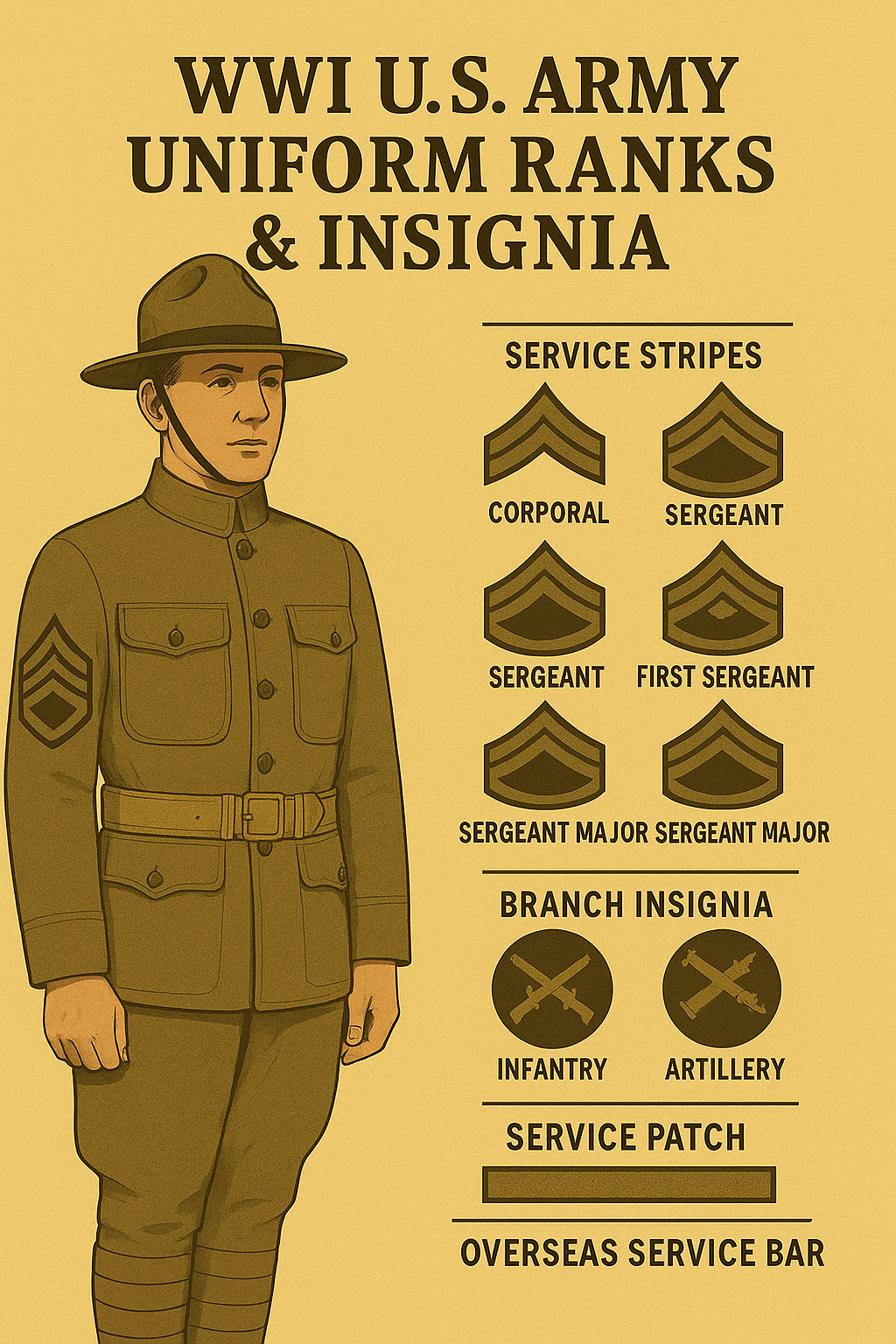
WWI U.S. Army Uniform Ranks and Insignia: A Complete Guide for Collectors and History Buffs
Published on Apr 20, 2025
Introduction
The uniforms worn by U.S. soldiers during World War I are more than just clothing — they’re historical documents in fabric form. Every stripe, chevron, patch, and emblem tells a story about duty, rank, branch, and experience. For anyone passionate about military history, reenactment, or uniform collecting, understanding these visual cues is key to preserving authenticity.
In this detailed guide, we’ll explore how ranks and insignia were displayed on WWI U.S. Army uniforms, how Marines adapted Army garments, and what each stripe or patch signified on the battlefield.
1. U.S. Army Rank Structure in World War I
In WWI, the U.S. Army had a more layered and specialized rank system than we see today. Ranks were divided into three main categories:
- Enlisted Personnel: Ranks such as Private, Corporal, and various classes of Sergeants.
- Specialists: Positions like Ordnance Sergeants, Master Electricians, and Artificers who had technical roles.
- Commissioned Officers: From Second Lieutenant up to General.
Each of these roles had designated insignia, which helped maintain discipline and order — especially crucial in the chaos of trench warfare.
2. Chevrons: The Backbone of Enlisted Insignia
Chevrons were the most widely recognized insignia for non-commissioned officers and were typically worn on both sleeves.
Design & Color:
- Chevrons were V-shaped stripes, pointing upward.
- Color indicated the soldier’s branch: for example, infantry chevrons were light blue, cavalry used yellow, and artillery featured red.
Standardization:
By 1917, olive drab became the default color for all field uniforms to simplify manufacturing and enhance camouflage, although branch colors were still seen in dress uniforms.
3. Patch and Insignia Placement on Army Uniforms
Knowing where insignia was placed on a uniform can help collectors and reenactors ensure historical accuracy.
Key Placements:
- Upper Sleeves: Rank chevrons and service specialty patches.
- Lower Left Sleeve: Overseas service bars — each bar representing six months of duty overseas.
- Lower Right Sleeve: Wound chevrons (indicating the soldier had been wounded in action).
- Collar & Lapels: Branch insignia or unit identifiers.
Placement wasn’t just aesthetic — it was practical and essential for maintaining hierarchy on the field.
4. Did the U.S. Marines Wear Army Uniforms in WWI?
This is a frequently asked question — and the answer is yes, to a degree.
While the U.S. Marine Corps had its own distinct dress and service uniforms, operational realities during World War I led many Marines, especially those deployed in France, to wear U.S. Army field uniforms. This was primarily due to logistical challenges and the need for standardized supply.
However, Marines continued to wear their branch-specific insignia, including the iconic Eagle, Globe, and Anchor, to distinguish themselves from Army personnel.
5. Meaning of Marine Stripes and Insignia in WWI
While visually similar to Army ranks, Marine Corps chevrons had their own color schemes and meanings. They played a vital role in showing both experience and rank.
Key Marine Uniform Insignia:
- Service Stripes: Located on the lower sleeve, each stripe represented four years of honorable service.
- Chevrons: Indicated non-commissioned rank like Corporal or Sergeant. Marines often had red chevrons on green wool uniforms.
- Specialty Marks: Crossed rifles, bugles, or artillery shells indicated specific military occupational specialties.
For collectors, spotting these small differences can dramatically affect a uniform’s historical and monetary value.
6. Evolution of Uniform Materials and Colors
The uniforms used by U.S. forces in WWI evolved rapidly in response to battlefield conditions.
Early War:
- Uniforms were still influenced by 19th-century styles, with blue and gray tones, ornate details, and brass buttons.
Mid to Late War:
- Olive drab and khaki became the standard for better camouflage.
- Heavy wool fabrics were replaced with lighter and more breathable materials to adapt to long field deployments.
These changes were vital not just for practicality, but also for unifying the appearance of the rapidly expanding U.S. military forces.
7. Collecting and Reenacting: Why Details Matter
Whether you're a historical reenactor or an avid collector of military memorabilia, getting the details right is key.
Tips for Authentic WWI Uniform Representation:
- Research Before You Buy: Look at period photographs and official records to ensure accuracy.
- Examine Stitching and Fabric: Original wool tunics and trousers had very distinct textures and weights.
- Insignia is Everything: Misplaced or incorrectly colored patches can significantly reduce the authenticity of a piece.
- Be Wary of Reproductions: Some modern replicas look great at first glance but are historically inaccurate upon closer inspection.
At Paddelaters, we specialize in accurate reproductions based on historical documents and original pieces, ensuring every item fits its time period perfectly.
Conclusion
WWI U.S. Army uniform ranks and insignia were more than military fashion—they were symbols of order, service, and identity in one of the most brutal conflicts in history. From chevrons denoting rank to patches revealing branch and experience, each piece of the uniform told a soldier's story.
Understanding these details is essential not just for historical knowledge, but for honoring the legacy of those who served. Whether you're recreating a battlefield display or preserving uniforms as part of a personal collection, every accurate detail helps keep history alive.
